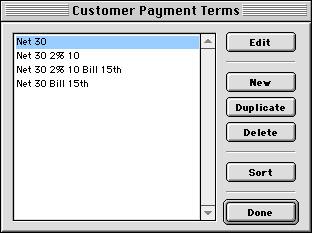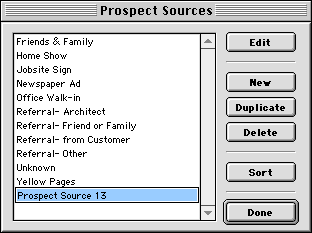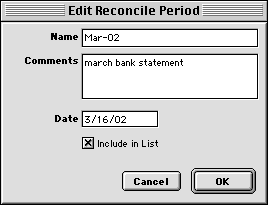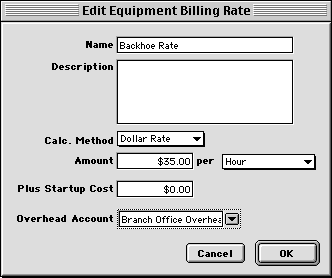|
The Goldenseal business
management software uses lists for many of the details of running
your business.
This lesson covers several basic lists-- for
payment terms, prospect sources, depreciation, billing rates,
tax packages, and delivery charges.
Viewing Lists
To view lists, use the menu commands at the top of the screen.
For example, to see the list of Customer
Payment Terms, follow these steps:
- Choose Payment Terms from the Options menu, then choose Customers from the
submenu.
- You will see a list of all the current payment terms for customer sales.

Entering List Items
To change a set of payment terms, double-click on an item in the list, or click
once on an item and then click the Edit button.
To create new terms, click the New button.
To copy existing terms, click once on an item and click Duplicate.
To delete an unused set of terms, click once on an item and click Delete.
To sort the list into alphabetical order, click the Sort button.
When you are finished with the list, click the Done button.
Using List Items
To use a list item, enter it into a clairvoyant field. For example, to give
a customer a different set of payment terms, follow these steps:
- Choose Customers from the Accounts menu.
- Enter the new terms into the Payment Terms clairvoyant field. You can use
the popup menu next to the field, or type in the name of the new payment terms.
You can also use the popup button in the clairvoyant field to see list items.
- Choose Edit Customer Payment Terms to see the whole list of terms.
- Choose View This Customer Payment Term to see the current terms.
Vendor Payment Terms
Use Vendor
Payment Terms to set the way you pay
for billed materials, subcontractors and other costs. To
enter terms, follow these steps:
- Choose Payment Terms from the Options menu, then choose Vendors from the
submenu.
- You'll see a list of payment terms for vendors.
- Select an item and click the Edit button, or click the New button to enter
new terms.
- Enter values into the fields. For example, to change the text that Goldenseal prints on each customer's
billing statements, change the text in the Form Message field. HINT: Check the Reference Manual
on the CD for more about the specific fields in this window.
- To save any changes that you have made, click the OK button. To leave without saving changes, click the
Cancel button.

Customer Payment Terms
Use Customer Payment Terms to set up your billing frequency, early-payment
discounts and finance charges for billed sales.
To modify a set of customer payment terms, follow these steps:
- Choose Payment Terms from the Options menu, then choose Customers from the
submenu.
- In the list of payment terms, double-click on the payment terms item you'd
like to change, or click the New button to make a new set of payment terms.
- Enter values into the fields, then click the OK button.

Prospect Sources
Use the Source field in the customer account to enter the way a customer first
heard about you. To enter Prospect Sources, follow these steps:
- Choose Income Setup from the Income menu, then choose Prospect
Sources from
the submenu.
- You'll see a list of possible sources.To add a new item, click the New button.
- Prospect Sources are a simple
list of names, so Goldenseal will add the new item directly to the list, instead
of showing you a separate dialog box.
- Type the new name directly into the list.
- To change an existing item, double-click on it (or click on the name, then click Edit). You can change
its name directly in the list.

More Simple Lists
Goldenseal includes several other simple lists. Choose Other Lists from the
Options menu, and enter any of the following:
- Actions Taken-- things you've done for problems, contacts and
documents.
- Appointment Type-- types of appointments for Appointment records.
- Contact Type-- types of meetings and calls for the Contact Log.
- Document Type-- types of documents for the Document Log
- Problem Type-- types of problems for the Problem Log.
- Tools-- simple tools that you use in projects.
- Unit Sizes-- sizes for Cost Items and Assemblies (e.g. square feet).
Depreciation Methods
Depreciation
Methods calculate depreciation for Real Estate and Equipment accounts.
To enter depreciation methods, follow these steps:
- Choose Cost Setup from the Costs menu, then choose Depreciation Methods
from the submenu.
- You'll see a list of methods. Click the New button.
- Enter a brief name for the depreciation method
- Enter any comments you have about this method.
- Enter the way you'll calculate depreciation for this item (see the
Reference manual for details).
- Most calculation methods fill in a depreciation table at right. You can scroll through the years to see
the amount of depreciation each year. For a Custom calculation method, enter percentages into
the table.

Reconcile Periods
Use Reconcile
Periods to mark off bank transactions when you reconcile an account
against the bank statement. To enter reconcile periods, follow these steps:
- Choose Other Lists from the Options menu, then choose Reconcile Periods
from the submenu.
- You'll see a list of periods. Click the New button.
- Enter a brief name, any comments you have, and a date for the period.
- Click OK.

Billing Rates
Use billing rates to set the amount you charge for time-and-materials work,
and job costs. There are separate rates for equipment, labor and subs.
To enter Equipment
Billing Rates, follow these steps:
- Choose Billing Rates from the Options menu, and choose Equipment from the
submenu.
- Enter a brief name for the billing rate, and any comments you have about it.
- Enter the way you'd like to calculate the rate.
- Enter an Overhead account to use for this rate.
- When you are finished, click the OK button.

Delivery Methods
The Delivery
Methods list identifies shipping and delivery methods for sales
transactions. It calculates any charges that you'll make for shipping or deliveries. The list uses a
table of values, so you can charge different amounts based on the price or weight of the order.
To enter a delivery method, follow these steps:
- Choose Income Setup from the Income menu, then choose Delivery Methods from
the submenu.
- You'll see a list of delivery methods. Select a method, and click the
Edit button (or click the New button to create a new method).
- Enter a brief name, and any comments you have about this item.
- Click on the first checkbox to determine whether sales tax is based on the customer's usual tax rate or
the tax rate for the Sales Branch (use the latter for sales that are not delivered).
Click on the second checkbox to determine whether delivery charges are taxable.
- Choose the text to fill into the address field in Sales.
- Choose the calculation method for the delivery charge. It can be based on the weight or the sale price.
It can be calculated as a percentage of the sale price, or as a flat dollar amount.
- Enter a charge into the Charge column in the first row.
- If the charge applies only up to a certain weight or amount, enter the cutoff amount into the Up To column.
- When there is only one charge for all items, you'll only need one row. If there are different charges for
different price ranges or weight ranges, press the Return key to enter another row. HINT: New
rows always have a From value that is equal to the previous row's Up To value. Goldenseal
does not let you enter Up To values that are not in ascending order.
- Repeat steps 7 to 9 as many times as you need.
- When you are finished, click the OK button.
- To leave the list of job sales taxes, click the Done button.

Finishing Up
There are about 60 lists used within the Goldenseal business management software, but they
all look similar to one of the lists we have already covered in this lesson.
You only need to use those lists that make sense for your business.
HINT: A starter company file already comes with many lists filled
in.
If you'd like to look at other lists, choose a submenu from any of the
following menu commands:
- Income menu-- Income Setup
- Costs menu-- Cost Setup or Payroll Setup
- Options menu-- Account Groups, Billing Rates, Contract Setup, Payment
Terms, Calculations or Other Lists
Before you move on, it's definitely time to take a break. What would happen
if you were called on to sing the Star Spangled Banner at baseball opening day, and the President of the
United States were there? This might be a good time to start learning the second verse.
HISTORY FACT FOR THE DAY: The writer of the national anthem,
Francis Scott Key, also invented the shower. His first version was used only for singing in, but he added
plumbing after his wife threatened to convert the space to chic hat storage.
ANOTHER HISTORY FACT FOR THE DAY: Mrs. Scott Key is famous in
her own right, since she invented the pink yard flamingo (along with her best friend Mae West).
Residents of Florida were so grateful that they named Key West in their mutual honor.
Start | Previous | Next | Directory | Index | Ref
Manual | Website
|



